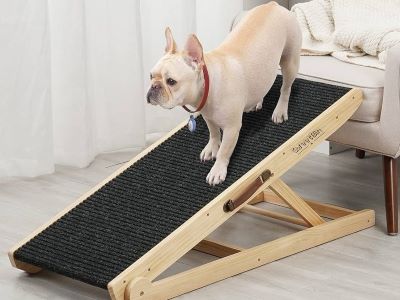Ever seen a dog try to tackle a ramp with all the grace of a cat on roller skates? Well, teaching your dog the art of ramp navigation isn’t just about avoiding hilarious YouTube moments. It’s a skill that can make life easier for your dog.🐶 But the big question remains: How to train a dog to use the ramp?

In this article, we’ll explore the various scenarios where ramp usage can be a game-changer, from helping senior dogs access furniture to safely loading your pup into the car.🚗
How to Train a Dog to Use the Ramp?
Training a dog🐕 to use a ramp can be a helpful skill, especially if you have a dog with mobility issues or if you want to teach your dog to get into a vehicle🚙 or onto furniture safely.🛋️
“In fact, dog🐶 stairs and ramps can also make life easier for some very small dogs or breeds with short legs and long bodies, like Dachshunds and Corgis”, says the experts at AKC.
Remember that consistent, positive reinforcement is key to successfully training your dog to use a ramp. Here are some tips:
1) Introduction to the Ramp
To start ramp training, let your dog take a curious stroll on the ramp when it’s placed on the ground. This initial exploration allows them to familiarize themselves with this new object in their environment.
Make this experience even more enticing by offering treats🍖 and enthusiastic praise. Reward your dog when they approach, sniff, or even put a paw🐾 on the ramp.

This positive reinforcement begins to build an enjoyable association with the ramp, setting the stage for further training adventures.
2) Basic Commands
It’s crucial that your dog has a solid grasp of fundamental commands such as “Sit“🔽 establishes control and focus, “Stay“⏸️ ensures your dog remains in a specific position, and “Come“➡️ indicate them to return to you when needed.
These commands serve as the building blocks of effective communication during training sessions and provide the foundation for a smoother and more successful ramp training experience.🐶
Tip: Take it slow, slower than a sloth. Let your dog savour each inch of that ramp like it’s a gourmet treat.🦥 Don’t rush them, or you might end up with a ‘ramp-rebellion’ on your hands! Remember, in the world of adventures, slow and steady wins the race… or should we say the ramp!🏁
3) Luring and Shaping
Harness the power of treats as your training allies. Begin by placing a treat at the base of the ramp, enticing your dog to approach. With the treat as a delicious motivator, gently guide your dog’s paws🐾 onto the ramp’s surface.
This encourages your dog to follow the scent and take confident steps on the ramp, ultimately forming the basis of their ramp-walking skills.
4) Regular Practice
Consistency is the name of the game🎮 when it comes to ramp training. So, schedule short and sweet training sessions frequently.
And here’s the twist: don’t just stick to going up the ramp; mix it up!🆙⬇️ Practice going down as well.
5) Verbal Cue
Communication is key🔑 in ramp training. Choose a word like “ramp” or “up” and use it consistently during training.

This word becomes the bridge between your instructions and your dog’s actions, making ramp training smoother and more effective.
6) Reduce Assistance
As your dog gains confidence, it’s time to gradually reduce the treats and assistance. Imagine you’re teaching your dog to ride a bike🚲 with training wheels. Initially, they need lots of support, but as they pedal and balance, you can start removing those extra wheels.
Similarly, decrease the frequency of treats🍖 and the physical assistance you provide. Some dogs may breeze through, while others might need a little extra time and encouragement.🥳
Tip: Training your dog🐶 to use a ramp may take time, so remain patient and persistent. Make ramp use a positive and rewarding🏆 experience. If your dog struggles or exhibits fear, seek expert👨⚕️ help as they can provide tailored advice and solutions.
7) Supervision and Safety
Always keep a watchful eye on your pup while they’re using the ramp, especially when they’re new to it. Just like you wouldn’t let someone dive into a pool without knowing how to swim, you’ll want to ensure your dog doesn’t take any risky leap of faith.✈️
Additionally, make sure the ramp is firmly secured in place and provides a non-slip surface. Safety first🥇, and then ramp on!
Why Is It Important to Teach Your Dog How to Use a Ramp?
Teaching your dog how to use a ramp can be incredibly important for a variety of reasons, here are some of them:
- Mobility Support: Ramps are vital for dogs with mobility issues, such as older dogs with arthritis or joint problems[1]. They provide a gentle incline that reduces strain on their joints, allowing them to access elevated surfaces like beds🛏️, sofas🛋️, or cars🚙 more comfortably.

- Injury Prevention: For young and active dogs, the best dog ramp can help prevent injuries caused by jumping off high↕️ surfaces. Jumping down from heights can put stress on a dog’s joints and spine🦴, potentially leading to injuries over time.
- Post-Surgery Recovery: After surgery🩺 or injury, dogs need a safe and gradual way to navigate inclines. Ramps offer a controlled and less stressful option for recovery.
- Specific Breeds: Smaller dog🐩 breeds often struggle to reach higher surfaces. Ramps make it easier for them to access these areas without straining or jumping. As dogs age, they may lose agility and ⚖️balance[2]. Ramps ensure that they can continue to enjoy their favourite spots without risking falls or injuries.
- Travel Convenience: Training your dog to use a ramp for getting into a vehicle simplifies travel, especially if you have a larger dog or a car with a higher entry point. See our guide on how to make a dog ramp for a car for tips.
- Independence: Ramps can empower your dog🐶 by allowing them to move independently. They won’t have to rely on you to lift them onto the couch or help them into the car.
- Safety: Ramps reduce the risk of accidents that can occur when dogs attempt to jump on or off furniture or vehicles. This is especially critical in preventing injuries in puppies.
FAQs
Is a Dog Ramp a Good Idea?
If you have a senior dog, a dog with arthritis, or a dog with other mobility issues, it may be time for dog stairs or a ramp. In fact, dog stairs and ramps can also make life easier for some very small dogs or breeds with short legs and long bodies, like Dachshunds and Corgis.
Do Dogs Prefer Stairs or Ramps?
If you have a young, active, or physically fit dog that does stairs all the time, they can probably manage well on stairs, while dogs who are not as physically able, or dogs for whom you want to stop or slow excessive stair use, would benefit more.
Why Won’t My Dog Use a Ramp?
One reason behind taking shortcuts is that a dog doesn’t yet feel 100% comfortable with walking on their ramp. In this scenario, place your dog’s ramp flat on the floor. Using a high-value reward, practice leading your dog back and forth across the full length of their ramp.
Summary
Training your dog to use a ramp is more than just a skill; it’s a gift of safety, mobility, and independence. Remember, patience and consistency go a long way in making the process enjoyable for both you and your dog.🐶
Whether it’s for senior dogs seeking comfort, small breeds reaching greater heights, or simply adding convenience to your daily routines, the ramp becomes a bridge to a smoother and safer life.🦺 But which is better dog ramp or dog stairs? That depends on your individual dog’s needs.
So, as you venture into this world of ramp training, ask yourself: “How to train a dog to use the ramp?” You’ll confidently answer, One step at a time, with love, treats, and a whole lot of tail-wagging enthusiasm! Your dog’s ramping success story begins now!⏲️
Reference:
- Hospital, B. M. V. (2021, June 10). Mobility issues in dogs and cats | Middlehope Veterinary Hospital.
- Hamby, G. (2021, December 26). How to help mobility in senior dogs | Vetericyn.



